Listed buildings in Wallasey
Wallasey is a town in Wirral, Merseyside, England. It contains 33 buildings that are recorded in the National Heritage List for England as designated listed buildings. Of these, two are listed at Grade II*, the middle of the three grades, and the others are at Grade II, the lowest grade. Originally a number of small separate villages, the town grew in the 19th century to become a dormitory town for Liverpool. It also contains part of Birkenhead Docks.[1] There are only four listed buildings dating from before the 19th century, namely the isolated tower of a medieval church, a house, a rectory, and a former grammar school. The later listed buildings include houses, churches, public houses, buildings associated with the docks, the town hall, part of a school, a watercourse, and a war memorial.
Key
| Grade | Criteria[2] |
|---|---|
| II* | Particularly important buildings of more than special interest |
| II | Buildings of national importance and special interest |
Buildings
| Name and location | Photograph | Date | Notes | Grade |
|---|---|---|---|---|
| Tower, St Hilary's Church 53.42119°N 3.06032°W |
 |
13th century | The tower of the original church stands separately from the present church, the rest having burnt down in 1857. The lower part is the older, and the upper parts date from 1530. The tower is in three stages with diagonal buttresses, and has blocked openings. In the top stage are louvred bell openings, and at the top of the tower is an embattled parapet with gargoyles.[1][3] | II |
| The Old House 53.41134°N 3.05171°W |
 |
1627 | A house mainly in stone with some brick at the rear and with a slate roof. It has two storeys and an attic, and is in three bays. The windows are mullioned, and there are two gabled dormers. The doorway has a large inscribed lintel and a hood mould.[4] | II |
| Old Rectory 53.42096°N 3.06116°W |
.jpg.webp) |
17th century | A stone house with a roughcast 20th-century extension. It has two storeys, an attic, and a basement. There is a two-bay front with a central entrance, mullioned windows, and a gabled dormer.[5] | II |
| 180 Breck Road 53.41809°N 3.05967°W |
 |
1799 | Built as Wallasey Grammar School and later used as a private house. It is in stone with a slate roof, in one storey and three bays. On the front are two blocked entrances, a glazed door, and casement windows. On the gabled street front are a blocked round-headed window and a sash window.[6][7] | II |
| 8–26 Manor Road 53.42128°N 3.04325°W |
 |
Early 19th century | A terrace of ten stone houses with slate roofs. They have two storeys, and each house has two bays. Two groups of four bays project forward under gables. Most of the windows are horizontally-sliding sashes.[8] | II |
| St John's Church 53.41624°N 3.03334°W |
.JPG.webp) |
1832–33 | A church, now redundant, by Henry Turberville Edwards in Neoclassical style. It is stuccoed with stone dressings and a stone façade. The façade has a Doric portico with four fluted columns, and an entablature with a triglyph frieze and a pediment. There are windows with architraves and pediments flanking the portico and along the sides of the church.[9][10] | II |
| St Paul's Church 53.40920°N 3.02023°W |
.JPG.webp) |
1846–47 | The church was designed by John Hay in the style of 1300, and was enlarged in 1859 and in 1891. It is in sandstone with Welsh slate roofs, and consists of a nave with a dormers, aisles, a north transept, a chancel, and a north vestry. At the northwest is a steeple with a three-stage tower with pinnacles and spire, shortened in height in the 20th century, and restored to its original height in 2013–14.[11][12][13] | II |
| Springvale Terrace 53.42077°N 3.03701°W |
 |
c. 1850 | A terrace of four brick houses with stone dressings and a slate roof. They have three storeys and nine bays, the outer two bays at each end projecting forward. The windows are sashes with wedge lintels. The entrances are round-headed with fanlights. The garden walls are included in the listing.[14] | II |
| St Alban's Church 53.41811°N 3.04457°W |
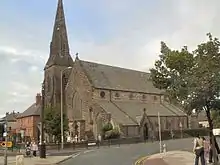 |
1852–53 | A Roman Catholic church by Stephen R. Eyre and Joseph Hansom in stone with a slate roof. It consists of a nave with a clerestory, a south aisle, a south porch, a chancel with a north vestry and a south Lady chapel, and a northwest steeple. The steeple has a tower with angle buttresses, and a broach spire with lucarnes.[15][16] | II |
| Gateway to former Liscard Battery 53.43235°N 3.03434°W |
 |
1858 | The entrance to the former battery is in stone, and has a central four-centred arch with a datestone above. This is flanked by octagonal towers with arrow slits, cornices and embattled parapets.[17] | II |
| St Hilary's Church 53.42164°N 3.05997°W |
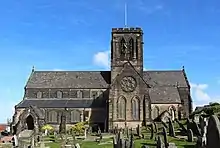 |
1858–59 | The church was built in the churchyard of a medieval church that had been destroyed by fire in 1857. It was designed by W. and J. Hay, and is built in stone with a slate roof. The church consists of a nave with a clerestory, aisles, transepts, a chancel with a north vestry and a south chapel, and a tower at the crossing. The tower has an embattled parapet with gargoyles, and an octagonal stair turret rising to a greater height.[1][18] | II |
| 4–6 Prospect Vale 53.42386°N 3.05904°W |
 |
c. 1860 | A pair of back-to-back houses in rendered stone with a slate roof. They have two storeys and three bays with central entrances. The windows in No. 4 are casements, and those in No. 6 are sashes.[19] | II |
| 8–10 Prospect Vale 53.42394°N 3.05847°W |
 |
c. 1860 | A pair of back-to-back houses in rendered stone with a slate roof. They have two storeys and three bays with central entrances and casement windows. No. 8 has a lean-to extension, and No. 10 has a 20th-century porch.[20] | II |
| 12–14 Prospect Vale 53.42405°N 3.05793°W |
 |
c. 1860 | A pair of back-to-back houses in rendered stone with a slate roof. They have two storeys and three bays with central entrances and 20th-century casement windows. Both houses have openwork lattice porches.[21] | II |
| Accumulator tower 53.40450°N 3.01570°W |
 |
1860 | The accumulator tower is at the entrance to Alfred Dock, it is built in brick, and has stone dressings. The tower has a square plan and is in two stages. It has corner buttresses, a corbelled cornice, and a coped parapet. The windows are round headed, and grouped in pairs and triplets. On the south side is a round-headed doorway.[22] | II |
| Water tower 53.41786°N 3.04578°W |
.JPG.webp) |
1860 | The water tower is in brick on a stone base with stone dressings. It has a square plan, is in five storeys, and in Romanesque style with a round-headed entrance. On each side is a giant arch containing pairs of round-headed windows with colonnettes. At the top is a Lombard frieze, a cornice, and a machicolated parapet.[23] | II |
| Grain warehouse (north) 53.40524°N 3.02835°W |
 |
1868 | The warehouse was designed by G. F. Lister, and has been converted into flats. It is in brick on a stone base, with stone dressings, and has six storeys, with 18 bays along the front and five along the sides. At the top is a corbelled parapet. The windows have projecting segmental lintels with keystones and imposts. On the front are loading bays, and at the north end is a turret.[24][25] | II |
| Grain warehouse (south) 53.40486°N 3.02855°W |
.JPG.webp) |
1868 | The warehouse was designed by G. F. Lister, and has been converted into flats. It is in brick on a stone base, with stone dressings, and has six storeys, with 24 bays along the front and five along the sides. At the top is a corbelled parapet. The windows have projecting segmental lintels with keystones and imposts. On the front are loading bays, and at the north end is a turret.[24][26] | II |
| Hydraulic generating station 53.40214°N 3.02230°W |
 |
1868 | The hydraulic generating station, now derelict, consists of an engine house and tower that were designed by J.B. Hartley. The engine house is in brick with stone dressings, it has three storeys and seven bays. A block connects it to a stone tower, which has buttresses, balconies, and clock faces. At the top are machicolations, and an embattled parapet with notched merlons.[27][28] | II |
| St Mary's Church 53.42325°N 3.03848°W |
 |
1876–77 | The church was designed by E. W. Nobbs, with G. E. Grayson as consultant, in Gothic Revival style, the tower was added in 1882, and the church was extended in 1907. It is built in local yellow sandstone with dressings in red sandstone from Runcorn, and has slate roofs. The church has an irregular cruciform plan consisting of a nave with a south porch, transepts, a chancel with vestries to the north and a lady chapel to the south, and a west tower. The tower has three stages, diagonal buttresses, an embattled parapet with crocketed pinnacles and gargoyles, and a pyramidal roof.[11][29] | II |
| Brighton public house 53.41582°N 3.02434°W |
 |
1886 | A public house in Gothic Revival style, built in stone and brick with slate roofs, on a corner site. It has two storeys, with four bays on Brighton Street, three on Buchanan Road, and a turret on the corner. The turret is polygonal and has a crenellated parapet and a spire. On the Brighton Street front is the main entrance with an oriel window above, and three gables surmounted by seated griffins. On the other front is an arched doorway and a canted and crenellated two-storey bay window.[30] | II |
| Pumping station 53.40217°N 3.01368°W |
 |
1886 | The pumping station was extended in 1908. It is in common brick with red brick dressings and a slate roof, and is in six bays by three bays, with a three-bay extension. Along the front is an arcade, partly blind and partly with segmental windows and round windows above. The ends are gabled, and on the roof are louvres. At the north end is a chimney stack with a machicolated cap.[31] | II |
| Church of Our Lady Star of the Sea 53.41136°N 3.02648°W |
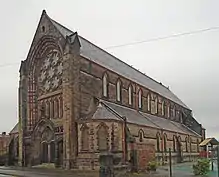 |
1888–89 | A Roman Catholic church by Edmund Kirby in stone with a slate roof. It consists of a nave with a clerestory, aisles, a chancel with a canted apse, chapels, a porch, and a baptistry. Most of the windows are lancets, there is a rose window at the west end, and the east window contains Geometric tracery.[15][32] | II |
| Memorial Chapel 53.42166°N 3.04101°W |
.JPG.webp) |
1898–99 | Originally a Unitarian church, it is now redundant and under the care of the Historic Chapels Trust. The church was designed by Edmund Waring and Edmund Rathbone in Arts and Crafts style. It is built in brick with stone dressings and has a tiled roof. The church has a rectangular plan, with a narthex at the front, a hall at the left, and a vestry and other rooms at the rear. The entrance is in an octagonal porch and has arches with columns, and a pyramidal roof. The fittings were designed by Art Nouveau craftsmen from the Bromsgrove Guild.[33][34] | II* |
| War Memorial 53.41633°N 3.03615°W |
.JPG.webp) |
1899–1920 | The memorial to the South African War is in Central Park, and is by J. Whitehead and Sons. It has a stone base containing inscribed names and a panel. On the base is a marble statue of Britannia standing and holding a wreath, a shield, and a flag.[35] | II |
| Gorsehill water tower 53.43388°N 3.04940°W |
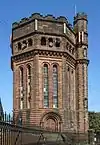 |
1902–05 | The stone water tower by J. H. Crowther is octagonal and has an octagonal turret rising to a greater height. The entrance and windows are round-headed, and in the top stage are round-headed openings with Ionic colonnettes. At the top of the tower is a cornice and a double-stepped embattled parapet.[6][36] | II |
| Manor Church Centre 53.42384°N 3.03248°W |
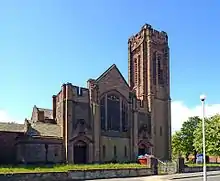 |
1907–08 | This church was originally a Presbyterian church, designed by Briggs, Wolstenholme and Thornley in a mixture of Arts and Crafts and Gothic Revival styles. It is in stone with a slate roof, and consists of a nave with narrow aisles, a north transept, a short chancel, and a southwest tower. A church hall was added in 1910. This is in Tudor style, and has mullioned and transomed windows.[15][37] | II |
| St Nicholas' Church 53.42944°N 3.07160°W |
.JPG.webp) |
1910–11 | A church in Storeton sandstone and roofed in Yorkshire stone flags, by J. F. Doyle with Perpendicular features. It has a cruciform plan, with a central tower, a nave and a chancel both with a clerestory, aisles, transepts, a Lady Chapel, a vestry, and porches. The tower has a battlemented parapet and a stair turret rising to a greater height. Inside the church, furnishings are in Arts and Crafts style.[11][38] | II |
| Town Hall 53.41574°N 3.02331°W |
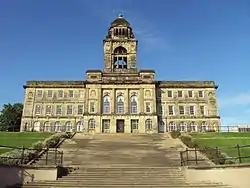 |
1914–20 | The town hall was designed by Briggs, Wolstenholme and Thornley, and is in limestone with Welsh slate roofs. It is in three storeys, and has a rectangular plan, with sides of 15 and 19 bays. In the centre is a three-stage tower with openings flanked by columns. At the corners are four figures sculpted by William Birnie Rhind. Above are porticos on each side, and a stepped pyramidal roof surmounted by a copper cupola.[39][40] | II |
| Seacombe Ferry Terminal 53.40980°N 3.01589°W |
 |
1930–33 | The ferry terminal was designed by L. St G. Wilkinson, it is in brick with dressings in Portland stone, and has tiled roofs. The building consists of two ranges at right angles, and along the ground floor of both ranges is a loggia carried on pairs of Doric columns. The range parallel to the River Mersey contains booking and entrance halls and is in a single storey. Its protruding central entrance block is in stone, flanking it are three bays on each side, and above it is a brick clock tower. The other range has two storeys and eleven bays. On the central bays is a stepped parapet with urns, a flagstaff, and the municipal coat of arms.[41][42] | II |
| Jellicoe watercourse 53.40784°N 3.11457°W |
— |
1952 | The watercourse is a cascade feature in the grounds of the former Cadbury factory designed by Geoffrey Jellicoe. The feature and associated structures are in concrete, brick and wrought iron. It has a linear plan and consists of a series of ten pools stepping down a slope. Associated with the feature are a retaining wall, viewing platforms, railings, and planters.[43] | II |
| English Martyrs' Church 53.42430°N 3.06340°W |
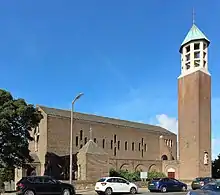 |
1952–53 | A Roman Catholic church by F. X. Velarde in Neo-Romanesque style. It is built in brick with decoration in cast stone, and with tiled roofs. The church consists of a nave with a clerestory, aisles, a Lady Chapel, and a sanctuary with a curved apse. There is an attached campanile with an octagonal cast stone lantern with a copper pyramidal roof surmounted by a cross. Inside the church is a statue and a font by Herbert Tyson Smith.[44][45] | II* |
| Solar Campus 53.41975°N 3.07948°W |
 |
1962 | A school building designed by Emsley A. Morgan to use and conserve passive solar energy. The south front is completely glazed with two skins of glass. Other parts are in brick, stone and timber, and the roof is felted. The building is mainly in two storeys and comprises an assembly hall, gymnasium, kitchen, and corridors.[46] | II |
References
Citations
- Hartwell et al. (2011), p. 650
- Historic England
- Historic England & 1259875
- Historic England & 1258157
- Historic England & 1258114
- Hartwell et al. (2011), p. 655
- Historic England & 1258058
- Historic England & 1273540
- Hartwell et al. (2011), pp. 650–651
- Historic England & 1258217
- Hartwell et al. (2011), p. 651
- Historic England & 1393180
- Finlason Partnership
- Historic England & 1258297
- Hartwell et al. (2011), p. 652
- Historic England & 1273542
- Historic England & 1273516
- Historic England & 1242754
- Historic England & 1258527
- Historic England & 1258534
- Historic England & 1273397
- Historic England & 1259874
- Historic England & 1258308
- Hartwell et al. (2011), p. 144
- Historic England & 1242755
- Historic England & 1258144
- Hartwell et al. (2011), p. 143
- Historic England & 1258186
- Historic England & 1435037
- Historic England & 1273431
- Historic England & 1258168
- Historic England & 1258191
- Hartwell et al. (2011), pp. 652–653
- Historic England & 1273517
- Historic England & 1258162
- Historic England & 1242756
- Historic England & 1258397
- Historic England & 1391526
- Hartwell et al. (2011), p. 653
- Historic England & 1258467
- Hartwell et al. (2011), p. 654
- Historic England & 1258535
- Historic England & 1466624
- Hartwell et al. (2011), pp. 651–652
- Historic England & 1390589
- Historic England & 1246185
Sources
- Historic England, "Tower to former church of St. Hilary to south west of present church, Wallasey (1259875)", National Heritage List for England, retrieved 5 December 2014
- Historic England, "The Old House, Wallasey (1258157)", National Heritage List for England, retrieved 3 December 2014
- Historic England, "Old Rectory, Wallasey (1258114)", National Heritage List for England, retrieved 3 December 2014
- Historic England, "No. 180 Breck Road, Wallasey (1258058)", National Heritage List for England, retrieved 3 December 2014
- Historic England, "Nos. 8–26 Manor Road, Wallasey (1273540)", National Heritage List for England, retrieved 5 December 2014
- Historic England, "Church of St John, Wallasey (1258217)", National Heritage List for England, retrieved 3 December 2014
- Historic England, "Church of St Paul, Wallasey (1393180)", National Heritage List for England, retrieved 6 December 2014
- Historic England, "Springvale Terrace including garden walls, Wallasey (1258297)", National Heritage List for England, retrieved 3 December 2014
- Historic England, "Church of St. Alban, Wallasey (1273542)", National Heritage List for England, retrieved 5 December 2014
- Historic England, "Gateway to former Liscard Battery, Wallasey (1273516)", National Heritage List for England, retrieved 5 December 2014
- Historic England, "Church of St Hilary, Wallasey (1242754)", National Heritage List for England, retrieved 2 December 2014
- Historic England, "Nos. 4–6 Prospect Vale, Wallasey (1258527)", National Heritage List for England, retrieved 3 December 2014
- Historic England, "Nos. 8–10 Prospect Vale, Wallasey (1258534)", National Heritage List for England, retrieved 3 December 2014
- Historic England, "Nos. 12–14 Prospect Vale, Wallasey (1273397)", National Heritage List for England, retrieved 5 December 2014
- Historic England, "Accumulator tower on south side of river entrance to Alfred Dock, Wallasey (1259874)", National Heritage List for England, retrieved 5 December 2014
- Historic England, "Wallasey Water Tower (1258308)", National Heritage List for England, retrieved 3 December 2014
- Historic England, "Grain warehouse to north of Grain Warehouse Dock, Wallasey (1242755)", National Heritage List for England, retrieved 2 December 2014
- Historic England, "Grain warehouse to south of Grain Warehouse Dock, Wallasey (1258144)", National Heritage List for England, retrieved 3 December 2014
- Historic England, "Hydraulic Generating Station, Wallasey (1258186)", National Heritage List for England, retrieved 3 December 2014
- Historic England, "Church of St Mary, Wallasey (1435037)", National Heritage List for England, retrieved 3 February 2017
- Historic England, "Brighton public house, Wallasey (1273431)", National Heritage List for England, retrieved 5 December 2014
- Historic England, "Pumping Station to east of Wallasey Dock (1258168)", National Heritage List for England, retrieved 3 December 2014
- Historic England, "Church of Our Lady Star of the Sea, Wallasey (1258191)", National Heritage List for England, retrieved 3 December 2014
- Historic England, "Memorial Chapel, Wallasey (1273517)", National Heritage List for England, retrieved 5 December 2014
- Historic England, "War Memorial to south east of Wirral Metropolitan College, Wallasey (1258162)", National Heritage List for England, retrieved 3 December 2014
- Historic England, "Gorsehill Water Tower, Wallasey (1242756)", National Heritage List for England, retrieved 2 December 2014
- Historic England, "Manor Church Centre, Wallasey (1258397)", National Heritage List for England, retrieved 3 December 2014
- Historic England, "Church of St Nicholas, Wallasey (1391526)", National Heritage List for England, retrieved 6 December 2014
- Historic England, "Wallasey Town Hall (1258467)", National Heritage List for England, retrieved 3 December 2014
- Historic England, "Seacombe Ferry Terminal, Wallasey (1258535)", National Heritage List for England, retrieved 5 December 2014
- Historic England, "Jellicoe watercourse, including associated retaining wall, viewing platforms, railings and planters at former Cadbury factory, Wallasey (1466624)", National Heritage List for England, retrieved 21 August 2020
- Historic England, "Roman Catholic Church of English Martyrs, Wallasey (1390589)", National Heritage List for England, retrieved 5 December 2014
- Historic England, "Solar Campus (formerly St Mary's Buildings), Wallasey (1246185)", National Heritage List for England, retrieved 2 December 2014
- Historic England, Listed Buildings, retrieved 3 April 2015
- Finlason Partnership, St Paul's Church, retrieved 7 December 2014
- Hartwell, Clare; Hyde, Matthew; Hubbard, Edward; Pevsner, Nikolaus (2011) [1971], Cheshire, The Buildings of England, New Haven and London: Yale University Press, ISBN 978-0-300-17043-6